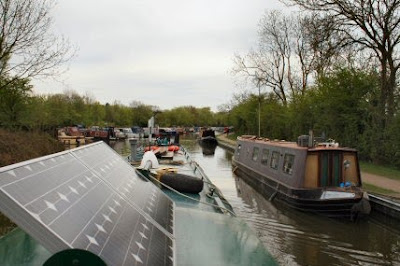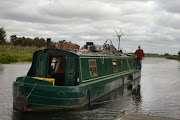As we left Macclesfield work had started on the burnt out hulk. The interior of the boat looks an absolute mess and there will be very little if anything that can be salvaged.
There is plenty of evidence of the amount of dredging that is being carried out. Apart from the empty barges at the exit from the marina I was passed by another workboat (Pollard) with digger onboard.
At the end of Macclesfield one goes through a cutting with well buttressed walls.
Soon out in the countryside again. The chipper is needed here. The canal is narrow and the overhanging trees aren't a help.
It piddled down with rain so stopped at the Gurnett Aqueduct. Below the aqueduct is The Old Kings Head. Dating from 1695 it fits in well with the many old buildings that make up this small hamlet. It was a coaching house and smithy and was once visited by Bonnie Prince Charlie. The house to the right of the pub is called The Forge and there is another small house at the back of similar age.
An oddly shaped house across the road from the Brindley cottage. There is a house below this view overlooking a stream. I wondered what the shuttered window was for. It does look like it was opened to sell something from.
The brick building on the far right has a letter box and is twice the size of an outside loo. It also has a 'serving hatch'. Anyone got any ideas?
Wikki - James Brindley - Born into a well-to-do family of yeoman farmers and craftsmen in the Peak District, which in those days was extremely isolated, he received little formal education but was educated at home by his mother.
The cottage beneath the Gurnett Aqueduct it is also known locally as Sutton Aqueduct.. There is a plaque on the wall saying that James Brindley lived on the spot during his apprenticeship to a millwright (Abraham Bennett) from 1733 - 1740.
At age 17, encouraged by his mother, he was apprenticed to a millwright in Sutton, Macclesfield and soon showed exceptional skill and ability. Having completed his apprenticeship he set up business for himself as a wheelwright in Leek, Staffordshire. In 1750 he expanded his business by renting a millwright's shop in Burslem from the Wedgewoods who became his lifelong friends. He soon established a reputation for ingenuity and skill at repairing many different kinds of machinery. In 1752 he designed and built an engine for draining a coal mine, the Wet Earth Colliery at Clifton in Lancashire. Three years later he built a machine for a silk-mill at Congleton.
Brindley's reputation brought him to the attention of the 3rd Duke of Bridgewater who was looking for a way to improve the transport of coal from his coal mines at Worsley to Manchester.
In 1759 The Duke commissioned the construction of a canal to do just that. The resulting Bridgewater Canal, opened in 1761, is often regarded as the first British canal of the modern era (though the Sankey Canal has a good claim to that title), and was a major technical triumph. Brindley was commissioned as the consulting engineer and, although he has often been credited as the genius behind the construction of the canal, it is now thought that the main designers were Sir Thomas Egerton himself, who had some engineering training, and the resident engineer John Gilbert. Brindley was engaged, at the insistence of Gilbert, to assist with particular problems such as the Barton Aqueduct. This most impressive feature of the canal carried the canal at an elevation of 13 metres (39 ft) over the River Irwell at Barton. (In 1893, on the building of the Manchester Ship Canal, the aqueduct was replaced by the equally impressive Barton Swing Aqueduct.)
Brindley's technique minimized the amount of earth moving by developing the principle of contouring. He preferred to use a circuitous route which avoided embankments, and tunnels rather than cuttings. Though this recognized the primitive methods of earth-moving available at the time, it meant that his canals were often much longer than a more adventurous approach would have produced. But his greatest contribution was the technique of clay puddling to make the bed of the canal watertight.
The view from bows looking down towards the Brindley cottage

























































